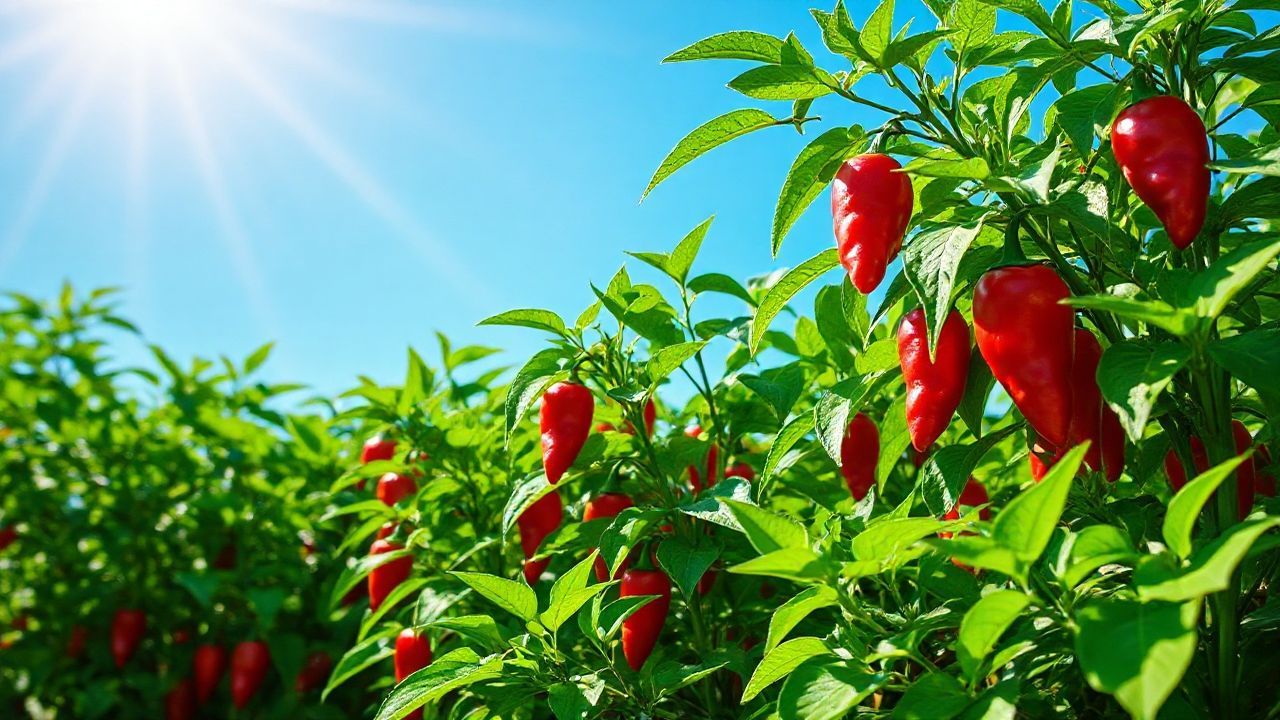Introduction to red peppers
Ideal conditions for growing red peppers
Red peppers, known for their vibrant color and sweet, slightly spicy flavor, thrive under specific environmental conditions. To achieve optimal growth and yield, it is crucial to provide these plants with the following ideal conditions:
Sunlight: Red peppers are sun-loving plants that require at least six hours of direct sunlight per day. Choose a well-drained location with ample sunlight exposure.
Temperature: Red peppers prefer warm temperatures between 70-80°F (21-27°C) during the day and 55-65°F (13-18°C) at night. Protect plants from frost or extreme heat by providing shade or frost covers when necessary.
Soil: Red peppers thrive in well-drained, fertile soil with a pH between 6.0-6.8. Amend the soil with organic matter, such as compost or manure, to improve drainage and provide nutrients.
Water: Water plants regularly, especially during hot, dry weather. Avoid overwatering, as soggy soil can lead to root rot. Allow the soil to dry slightly between waterings.
Fertilizer: Fertilize plants every two to three weeks with a balanced fertilizer. Avoid using nitrogen-rich fertilizers, as they can promote excessive leaf growth at the expense of fruit production.
Mulch: Cover the soil around plants with organic mulch, such as straw or wood chips. Mulch helps retain moisture, suppress weeds, and regulate soil temperature.
Support: As plants grow taller, they may require support to prevent stems from breaking under the weight of the fruit. Use stakes, cages, or trellises to provide support.
Pest and Disease Control: Red peppers can be susceptible to certain pests and diseases. Monitor plants regularly and take appropriate control measures as needed.
Planting red pepper seeds
Embarking on the rewarding journey of growing your own red peppers begins with the delicate yet crucial task of planting the seeds. These vibrant gems hold the potential for producing an abundance of flavorful and nutritious harvests, so it’s essential to lay a solid foundation from the start. Selecting high-quality seeds from a reputable source is paramount. Once you have your seeds in hand, the following steps will guide you through the intricacies of planting them successfully:
1. Prepare the Seedling Trays or Pots: Fill seedling trays or small pots with a well-draining seed-starting mix. Moisten the soil thoroughly before planting.
2. Sow the Seeds: Make shallow depressions in the soil, about 1/4 inch deep and spaced 2 inches apart. Gently place one seed in each depression and cover it with soil.
3. Water Carefully: Mist the soil gently with water to keep it moist but not soggy. Avoid overwatering, as this can hinder germination.
4. Cover and Place in Warmth: Cover the trays or pots with plastic wrap or a humidity dome to maintain moisture. Place them in a warm location with a constant temperature between 70-85°F (21-29°C).
5. Monitor Germination: Red pepper seeds typically germinate within 10-14 days under ideal conditions. Keep the soil moist and provide ample light by placing the trays or pots in a sunny window or under grow lights.
6. Thinning: Once the seedlings have developed their first set of true leaves (not the cotyledons), it’s time to thin them out. Gently remove weaker or crowded seedlings, leaving the strongest one in each cell or pot.
Caring for red pepper plants
Harvesting red peppers
As your red peppers ripen, you’ll notice they turn from a vibrant green to a deep, glossy red. This is a sign that they’re ready to be harvested. To ensure optimal flavor and quality, it’s crucial to harvest peppers at the right time and with proper technique.
Harvesting red peppers is relatively easy, but there are a few key things to keep in mind. First, check the ripeness of the peppers by gently squeezing them. If the peppers feel firm and slightly soft, they’re ripe. Avoid harvesting peppers that are still green or have any signs of bruising or damage.
To harvest peppers, simply use a sharp knife or a pair of sharp scissors to cut the stem cleanly. Be careful not to cut too close to the pepper’s body, as this can damage the fruit. Once harvested, peppers can be stored in a cool, dry place for several weeks.
When harvesting red peppers, it’s important to consider the weather and temperature. Avoid harvesting peppers on extremely hot or rainy days, as this can affect their quality and shelf life. If possible, harvest peppers in the early morning or evening when the temperatures are cooler.
By following these tips, you can enjoy a bountiful harvest of fresh, flavorful red peppers that will add color and nutrients to your dishes.
Conclusion: Grow fresh red peppers at home
Growing red peppers at home is an incredibly rewarding endeavor that unlocks a world of culinary adventures. Whether you’re a seasoned gardener or a budding enthusiast, embracing this pursuit will not only provide you with delicious, home-grown produce but also a profound sense of accomplishment. Embarking on this journey requires careful planning, optimal soil conditions, and unwavering dedication, yet the rewards far outweigh the challenges. By nurturing these vibrant plants through their lifecycle, you’ll not only harvest the freshest red peppers but also witness the transformative power of nature firsthand. Allow this comprehensive guide to serve as your constant companion, providing you with the knowledge and strategies necessary to cultivate a thriving red pepper patch that will become a culinary oasis in your backyard.

Leave a Reply